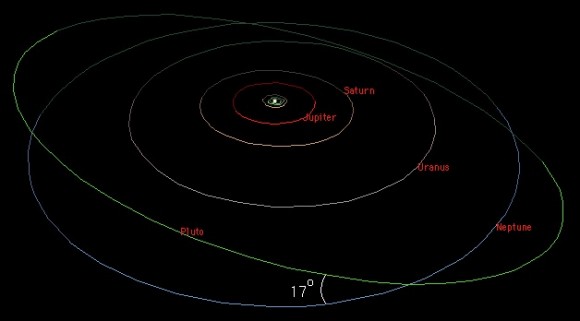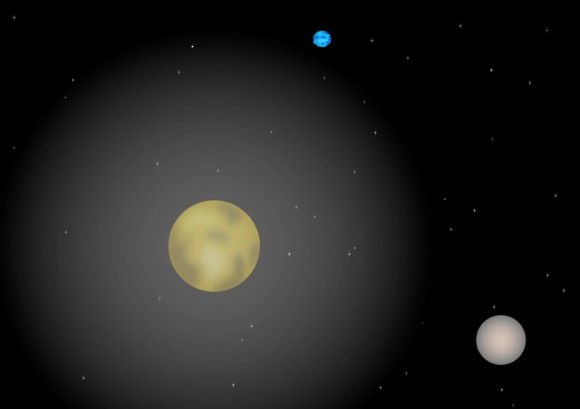[/caption]
Ah, Pluto. Seems every time we think we’ve got it figured out, it has a new surprise to throw at us.
First spotted in 1930 by a young Clyde Tombaugh, for 76 years it enjoyed a comfortable position as the solar system’s most distant planet. Then a controversial decision in 2006 by the International Astronomical Union, spurred by suggestions from astronomer (and self-confessed “planet-killer”) Mike Brown*, relegated Pluto to a new class of worlds called “dwarf planets”. Not quite planets and not quite asteroids, dwarf planets cannot entirely clear their orbital path with their own gravitational force and thus miss out on full planetary status. Besides immediately making a lot of science textbooks obsolete and rendering the handy mnemonic “My Very Eager Mother Just Served Us Nine Pies” irrelevant (or at least confusing), the decision angered many people around the world, both in and out of the scientific community. Pluto is a planet, they said, it always has been and always will be! Save Pluto! the schoolkids wrote in crayon to planetarium directors. The world all of a sudden realized how much people liked having Pluto as the “last” planet, and didn’t want to see it demoted by decision, especially a highly contested one.
Yet as it turns out, Pluto really may not be a planet after all.
It may be a comet.
But…that’s getting ahead of ourselves. First things first.

Recent discoveries by a UK team of astronomers points to the presence of carbon monoxide in Pluto’s atmosphere. Yes, Pluto has an atmosphere; astronomers have known about it since 1988. At first assumed to be about 100km thick, it was later estimated to extend out about 1500km and be composed of methane gas and nitrogen. This gas would expand from the planet’s – er, dwarf planet’s – surface as it came closer to the Sun during the course of its eccentric 248-year orbit and then freeze back onto the surface as it moved further away. The new findings from the University of St Andrews team, made by observations with the James Clerk Maxwell telescope in Hawaii, identify an even thicker atmosphere containing carbon monoxide that extends over 3000 km, reaching nearly halfway to Pluto’s largest moon, Charon.
It’s possible that this carbon monoxide atmosphere may have expanded outwards from Pluto, especially in the years since 1989 when it made the closest approach to the Sun in its orbit. Surface heating (and the term “heating” is used scientifically here…remember, at around -240ºC (-400ºF) Pluto would seem anything but balmy to us!) by the Sun’s radiation would have warmed the surface and expelled these gases outwards. This also coincides with observations made by the Hubble Space Telescope over the course of four years, which revealed varying patterns of dark and light areas on Pluto’s surface – possibly caused by the thawing of frozen areas that shift and reveal lighter surface material below.
“Seeing such an example of extra-terrestrial climate-change is fascinating. This cold simple atmosphere that is strongly driven by the heat from the Sun could give us important clues to how some of the basic physics works, and act as a contrasting test-bed to help us better understand the Earth’s atmosphere.”
– Dr. Jane Greaves, Team Leader
In fact, carbon monoxide may be the key to why Pluto even still has an atmosphere. Unlike methane, which is a greenhouse gas, carbon monoxide acts as a coolant; it may be keeping Pluto’s fragile atmosphere from heating up too much and escaping into space entirely! Over the decades and centuries that it takes for Pluto to complete a single year, the balance between these two gases must be extremely precise.
Read more about this discovery on the Royal Astronomical Society’s site.

So here we have Pluto exhibiting an expanding atmosphere of thawing expelled gas as it gets closer to the Sun in an elliptical, eccentric orbit. (Sound familiar?) And now there’s another unusual, un-planet-like feature that’s being put on the table: Pluto may have a tail.
Actually this is an elaboration of the research results coming from the same team at the University of St Andrews. The additional element here is a tiny redshift detected in the carbon monoxide signature, indicating that it is moving away from us in an unusual way. It’s possible that this could be caused by the top layers of Pluto’s atmosphere – where the carbon monoxide resides – being blown back by the solar wind into, literally, a tail.
That sounds an awful lot, to this particular astronomy reporter anyway, like a comet.
Just saying.
Anyway, regardless of what Pluto is or isn’t, will be called or used to be called, there’s no denying that it is a fascinating little world that deserves our attention. (And it will be getting plenty of that come July 2015 when the New Horizons spacecraft swings by for a visit!) I’m sure there’s no one here who would argue that fact.
New Horizons’ upcoming visit will surely answer many questions about Pluto – whatever it is – and most likely raise even more.

The new discovery was presented by team leader Dr. Jane Greaves on Wednesday, April 20 at the National Astronomy Meeting in Wales.
Article reference: arxiv.org/abs/1104.3014: Discovery Of Carbon Monoxide In The Upper Atmosphere Of Pluto
*No disrespect to Mr. Brown intended…he was just performing science as he saw fit!



